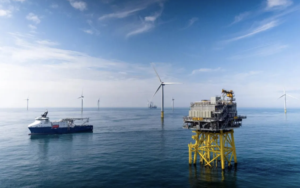
By Steve Haner
The New York State Public Service Commission (PSC) last week told several offshore wind developers it would not approve changes in their state contracts, putting several planned ocean turbine projects into jeopardy. The story is important for its contrast to how Virginia faces the same future.
First, the New York projects in question are all being privately developed, with the financial risk being taken by the wind turbine manufacturers, mostly foreign-owned. They have all agreed to fixed contract prices for future electricity deliveries, prices which they were asking the PSC to increase 27 to 54% due to changes in their projected construction costs.
In Virginia, the first phase of Dominion Energy Virginia’s Coastal Virginia Offshore Wind project is utility-owned and the financial risk for cost overruns rests initially with those ratepayers, although should the costs get high enough the utility begins to share some of them.
The second disappointing contrast with Virginia is that New York’s PSC had the will and political independence to tell the wind developers, and their allies in the climate catastrophe movement, to go pound sand. Virginia’s State Corporation Commission is still hobbled by two vacancies on its governing three-judge panel, and Virginia’s Virginia Clean Economy Act and other laws impede the SCC’s authority to make low consumer cost the major consideration.
It is hard to imagine the current SCC writing what the New York regulators wrote in their news release last week:
On a monthly bill basis, granting the request to amend the executed contracts outside the competitive procurement process would have resulted in as high as 6.7 percent increases for residential customers and as high as 10.5 percent for commercial or industrial customers on monthly bills depending on service territory and the level of relief provided — above what was already committed.
The Commission said that the decision reaffirms that competitive procurement is the best, most efficient way to help New York reach its goal of having at least 70 percent of electric load served by renewable energy by 2030, development of 9,000 megawatts of offshore wind energy by 2035 and meeting statewide demand with zero emissions resources by 2040.
Governor Glenn Youngkin (R) made a half-hearted effort during the last General Assembly to pass legislation to create a competitive procurement process for the planned second wave of Dominion’s offshore wind. The bill didn’t even get a vote in committee. New Yorkers are much better protected than Virginians as we enter this Brave New World of high-cost and low-reliability power.
In fact, at the height of this year’s watershed General Assembly elections, candidates are mostly silent on issues surrounding the offshore wind plans, Dominion’s and also Avangrid’s, since it wants to build power cables through Virginia Beach. Again, it is easy to find a strong contrast in the other state with legislative elections this year, New Jersey.
There, several Republican candidates are challenging the current offshore wind plans, partly over concerns that the development process is killing whales and partly over the cost issues. In New Jersey, also working with independent developers offering fixed price contracts, one developer has gotten its legislature to sweeten its deal by allowing it to fully retain the federal incentive payments. Those subsidies were intended to lower the ultimate consumer costs, but will not in New Jersey.
The New Jersey Monitor, apparently a sister outlet to Virginia Mercury, wrote earlier this month about how some Republican candidates are raising the issue:
Days after (Governor) Murphy signed the Ørsted bill, Atlantic Shores Offshore Wind, a second wind developer, said it too will need government aid to avoid risking a separate project for a 1,509 MW wind farm.
“That’s kind of where this gets tricky, right? If you’re going to give out $1 billion to one company, the next company is going to want their slice of the pie, and that’s where we get into the problem with these tax credits going to these foreign companies to do these projects,” said Chris Del Borrello, a Republican seeking the 4th District’s Senate seat.
When the smoke clears November 8, it will be interesting to compare the level of Republican elective successes in New Jersey with those in Virginia.
New Jersey’s regulators are also facing petitions from developers seeking amendments to their power purchase agreements. The unanimous denial in New York could strengthen the resolve in New Jersey. Returning to the story from New York, its regulators insist that their decision in no way puts any crimp in the state’s rush to a green energy nirvana in just a few short years. From Politico’s report:
Environmental advocates, labor unions and the companies have said New York will not be able to meet its environmental goals if the commission rejects the higher subsidies. The offshore wind developers expressed disappointment.
But PSC Chair Rory Christian pushed back on that claim during the commission’s highly anticipated meeting. He said the state would continue to move forward with investments in clean energy. It’s also a decision of the developers to cancel their contracts, he emphasized.
“These projects are not everything. They do not represent the entirety of our efforts to fight climate change,” Christian said. “They’re one part of our portfolio, and as with any portfolio, different assets produce different results.”
Similar bravado issued from New York’s governor. In a state as historically hostile to nuclear power as is New York, and as poorly situated for solar, that qualifies as half comedy, half magical thinking.

Leave a Reply
You must be logged in to post a comment.